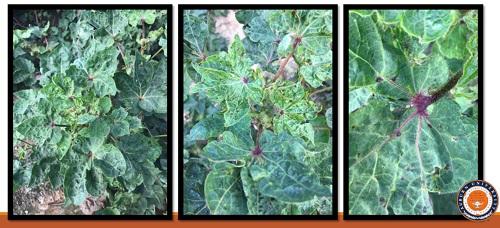
Credit: Kathy Lawrence and Auburn University
St. Paul, MN (October, 2019)–In August 2017, Kathy S. Lawrence, a plant pathologist at Auburn University, received a call from Drew Schrimsher of Agri-AFC, who had discovered foliar distortion and leaf curling and rolling on approximately 50,000 acres of cotton in southeastern Alabama. After ruling out herbicide damage, Schrimsher contacted Lawrence, and she visited the fields 2 days later.
Lawrence took samples and sent them to Judith K. Brown at the University of Arizona. After 7 months of research, Brown connected the symptoms to cotton blue disease, caused by Cotton leafroll dwarf virus (CLRDV). The disease had never been seen in the United States. It was first reported in Africa in 1949 and then not again until 2005, when it was reported in Brazil.
Reported from six counties in coastal Alabama in 2017, cotton blue disease affected approximately 25% of the state’s cotton crop and caused a 4% yield loss. The disease was reported again in 2018, affecting 3-100% of cotton fields in Alabama but causing only a 1% yield loss.
Symptoms, which include slowed plant growth, loss of chlorophyll, and dwarfing of infected leaves, usually do not appear until last August after full bloom. To date, there are no recommended strategies for management of this disease.
The full story behind the discovery of cotton blue disease in Alabama is presented in two “Focus on Cotton” webcasts: the 13-minute “Cotton Blue Disease Caused by Cotton leafroll dwarf like virus: Identification, Symptomology, and Occurrence in Alabama,” by Kathy S. Lawrence, and the 33-minute “Introduction of Cotton leaf roll dwarf-like Polerovirus into the United States: High-Throughput Discovery, Identification, and Genomic Comparisons,” by Judith K. Brown.
Both presentations are available through the “Focus on Cotton” resource on the Plant Management Network. This resource contains more than 75 webcasts, along with presentations from six conferences, on a broad range of aspects of cotton crop management: agronomic practices, diseases, harvest and ginning, insects, irrigation, nematodes, precision agriculture, soil health and crop fertility, and weeds. These webcasts are available to readers open access (without a subscription).
The “Focus on Cotton” homepage also provides access to “Cotton Cultivated,” a new resource from Cotton Incorporated that helps users quickly find the most current cotton production information available. These and other resources are freely available courtesy of Cotton Incorporated at http://www.
###
Media Contact
Ashley Bergman Carlin
[email protected]
651-994-3832




